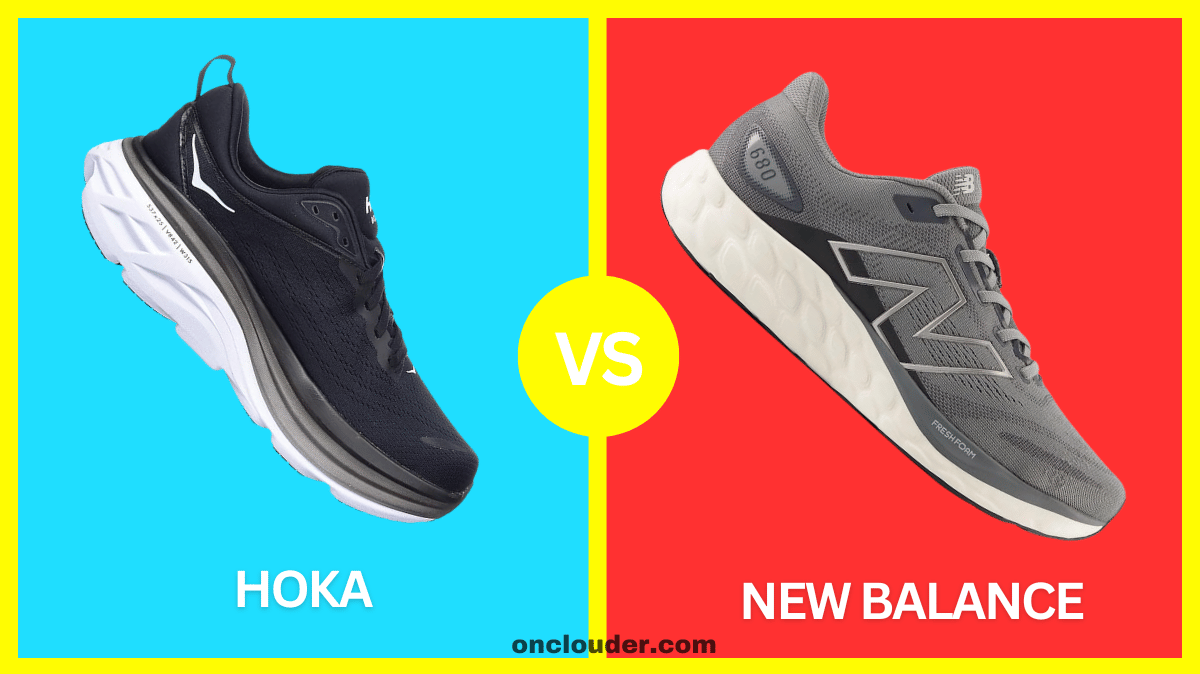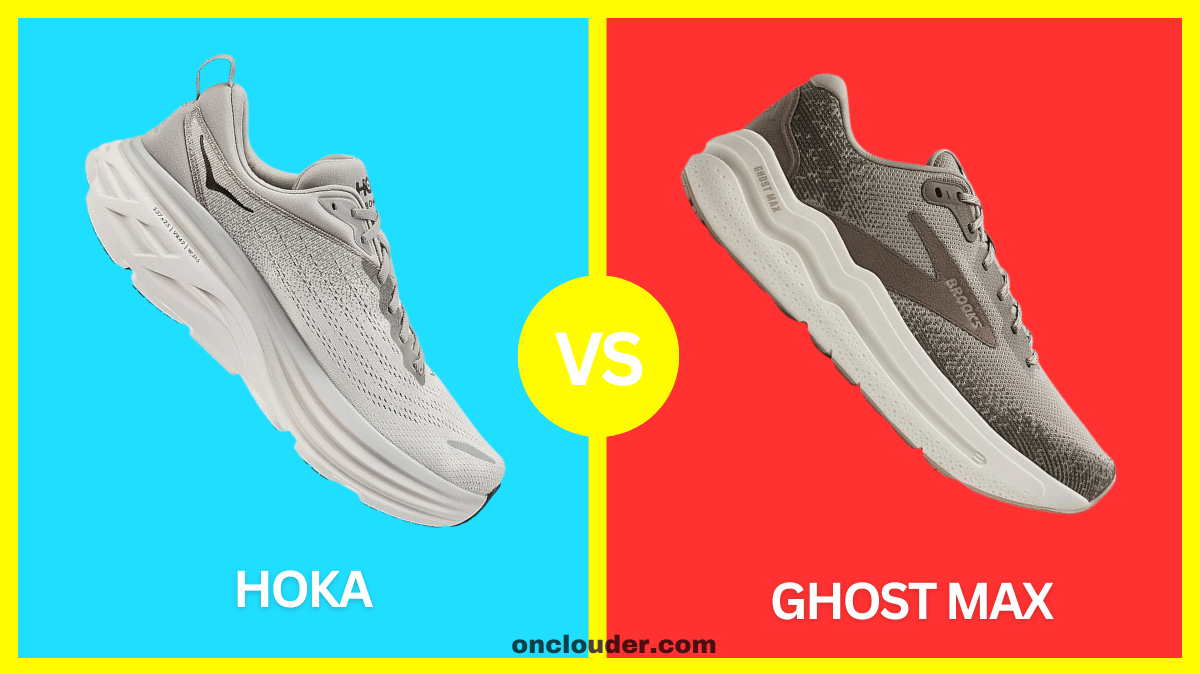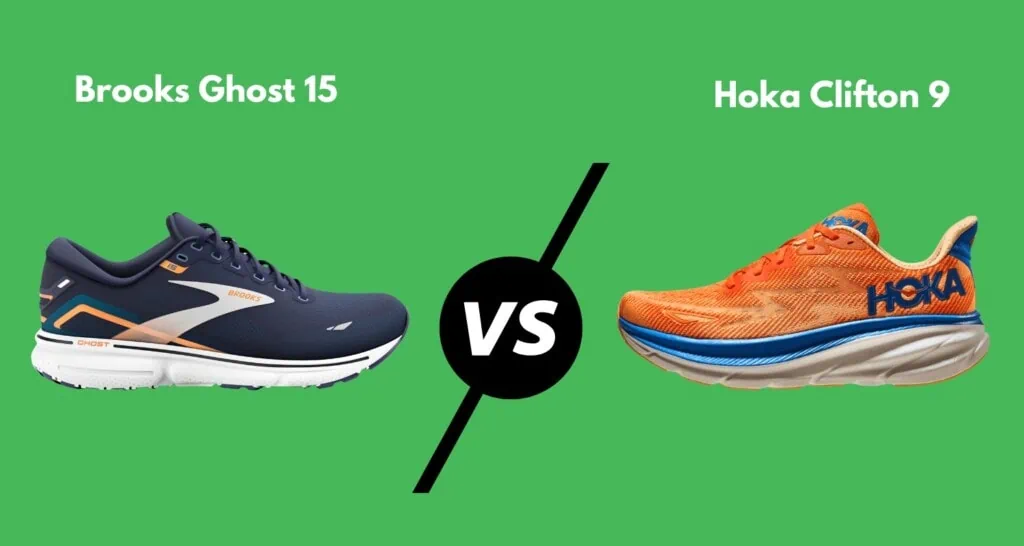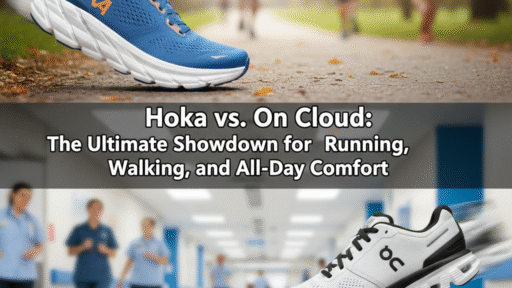Are you looking for the perfect pair of shoes? Let’s compare two popular brands: Hoka vs New Balance. We’ll look at different features to help you decide which one might be best for you.
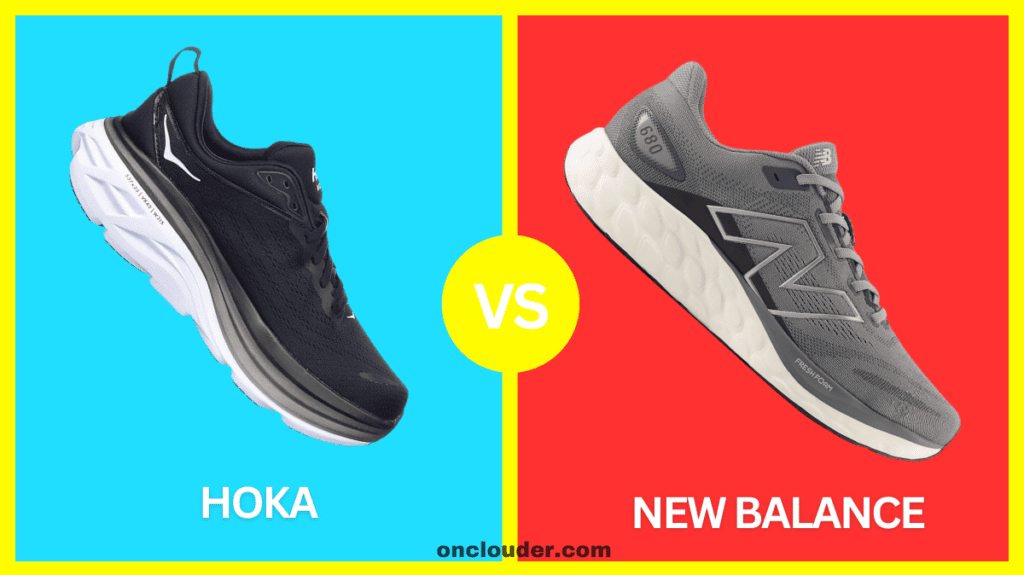
Contents
Hoka vs New Balance Shoes
The main difference between Hoka and New Balance shoes is cushioning. Hoka offers maximum cushioning with thick soles, while New Balance provides a range from minimal to high cushioning.
Hoka has a unique, chunky look, whereas New Balance offers more traditional styles. Both brands make quality running shoes, but cater to different preferences.
Now, let’s create a detailed comparison table for Hoka vs New Balance Shoes:
| Feature | Hoka | New Balance |
| Cushioning | Maximum | Varies (minimal to high) |
| Look | Unique, thick soles | Traditional |
| Fit | Wide toe box, snug heel | Various width options |
| Weight | Light for their size | Varies by model |
| Price | $130 – $200 | $80 – $180 |
| Best for | Long runs, joint comfort | Various running needs |
In summary: Hoka shoes have lots of cushioning and a unique look. They’re great for long runs. New Balance offers more choices in cushioning and style. They fit many running needs. Choose based on your comfort and running style.
Also Read: Hoka vs Oofos
Comfort and Cushioning
Hoka: Cloud-like Comfort
Hoka shoes are known for their thick, soft soles. They feel like walking on clouds! Many runners love how comfy they are, especially for long distances. Hoka uses special foam in their soles that provides lots of cushioning without adding too much weight. This can help reduce the impact on your joints when you’re running or walking.
Hoka’s signature “Meta-Rocker” technology is designed to propel you forward and make your stride smoother. This can make running feel easier and more comfortable, especially over long distances. Some people say it feels like the shoe is doing some of the work for them!
New Balance: Balanced Support
New Balance offers a mix of comfort and support. Their shoes have good cushioning but aren’t as thick as Hoka’s. This makes them great for everyday wear and various activities. New Balance uses different types of cushioning in their shoes, including their Fresh Foam and FuelCell technologies.
Fresh Foam provides a soft, plush feel that many people find very comfortable. It’s a bit firmer than Hoka’s cushioning, which some people prefer. FuelCell is designed to be responsive and provide energy return, which can help you feel bouncy and energetic when you’re running or walking.
New Balance also offers shoes with different levels of cushioning, from minimal to maximum. This means you can choose how much softness you want based on your preferences and the type of activity you’re doing.
Fit and Size
Hoka: Roomy Toe Box
Hoka shoes often have a wide front part, giving your toes lots of space. This can be great if you have wider feet or like extra room. The extra space allows your toes to spread out naturally, which can be more comfortable and may help with balance.
However, some people with narrow feet might find Hoka shoes too roomy. If you have narrow feet, you might need to try on a few different Hoka models to find one that fits well. Some Hoka shoes come with special lacing systems that can help you adjust the fit.
Hoka shoes sometimes run a bit large, so you might need to try a half size smaller than your usual size. It’s always a good idea to try on Hoka shoes before buying if you can, or to check their sizing guide carefully if you’re ordering online.
New Balance: Various Width Options
New Balance is famous for offering many width options. Whether you have narrow or wide feet, you’re likely to find a good fit. They typically offer widths from narrow (B) to extra-wide (4E) in many of their models. This is great because having shoes that fit well in width as well as length can make a big difference in comfort.
New Balance shoes often have a more traditional fit compared to Hoka. They usually have a snugger heel and midfoot area, with a toe box that’s roomy but not as wide as Hoka’s. This can provide a more secure feel, which some people prefer.
New Balance also offers different fits for different purposes. Their running shoes often have a snugger fit to prevent your foot from sliding around, while their walking shoes might have a bit more room for comfort.
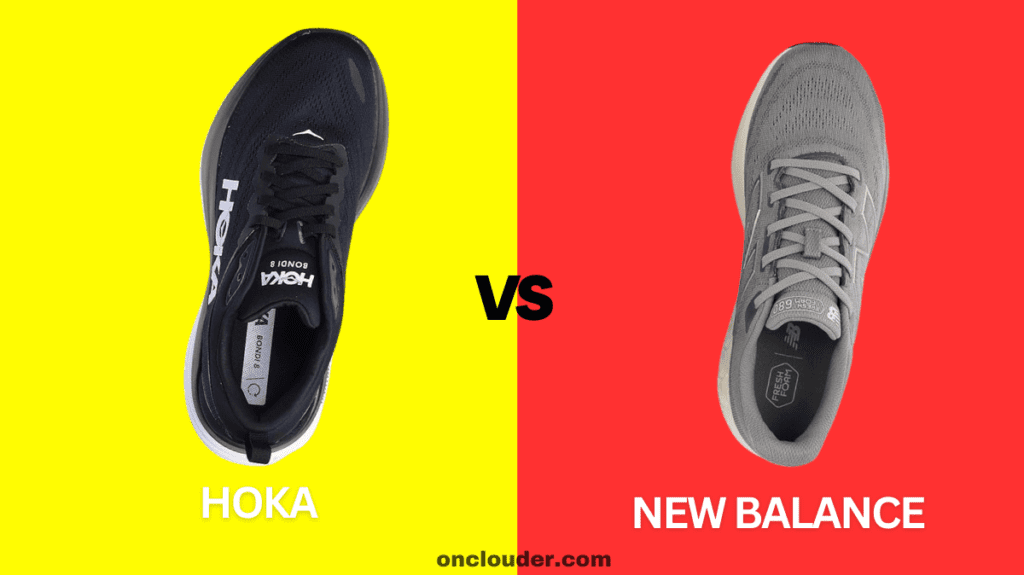
Durability
Hoka: Built to Last
Hoka shoes are made with strong materials. They can handle many miles of running or walking before wearing out. The thick soles not only provide cushioning but also add to the shoe’s durability. Many runners report being able to put hundreds of miles on their Hoka shoes before needing to replace them.
Hoka uses high-quality rubbers in their outsoles (the bottom part of the shoe that touches the ground). These are designed to resist wear and provide good traction. Some Hoka models use special rubbers in high-wear areas to make the shoes last even longer.
The upper parts of Hoka shoes (the fabric part that goes over your foot) are usually made from durable materials too. They use strong mesh and reinforced areas to prevent tears and wear.
New Balance: Dependable Quality
New Balance also makes durable shoes. They use good materials and construction methods to ensure their shoes last a long time. New Balance has been making shoes for a long time, and they have a reputation for quality.
Like Hoka, New Balance uses strong rubbers in their outsoles. They often use their own special rubber compounds that are designed to last a long time and provide good grip. Some New Balance shoes have extra-durable outsoles for activities like trail running.
New Balance is known for their attention to detail in construction. Their shoes often have reinforced stitching in areas that get a lot of wear, which helps them last longer. They also use durable materials in their uppers, including both synthetic materials and real leather in some models.
Also Read: Hoka vs Ghost Max
Breathability
Hoka: Keeping Feet Cool
Many Hoka shoes have breathable upper parts. This helps keep your feet from getting too sweaty during exercise. Hoka often uses lightweight mesh materials that allow air to flow through the shoe. This can help keep your feet dry and comfortable, even during long runs or on hot days.
Some Hoka models have special features to improve breathability. For example, they might have extra ventilation holes in key areas or use materials that are designed to wick moisture away from your feet.
New Balance: Air Flow Design
New Balance uses mesh and other materials to make sure air can flow through their shoes. This helps keep your feet dry and comfortable. Like Hoka, New Balance understands the importance of breathability for comfort and foot health.
Many New Balance shoes have a lightweight, breathable upper that allows good airflow. They often use engineered mesh, which means the mesh is designed to be more open in areas where you need more ventilation and more closed in areas where you need more support.
New Balance also offers shoes with different levels of breathability for different purposes. Their running shoes are often very breathable, while shoes designed for colder weather might prioritize warmth over ventilation.
Stability
Hoka: Extra Support
Hoka shoes often have wide bases and special designs to keep your feet stable. This can help prevent twisting your ankle. The wide base gives you a larger platform to stand on, which can improve balance and stability.
Many Hoka shoes also have a feature called the “Active Foot Frame.” This is like a bucket seat for your foot, where your heel sits deeper in the shoe. This can help keep your foot in place and improve stability.
Despite their thick soles, Hoka shoes are often surprisingly stable. The Meta-Rocker design helps guide your foot through its natural motion, which can contribute to stability when running or walking.
New Balance: Balanced Stability
New Balance offers different levels of stability in their shoes. Some models have extra support, while others are more flexible. This means you can choose a shoe that matches your needs.
For people who need extra stability, New Balance offers shoes with features like medial posts (firmer foam on the inner side of the shoe) and structured heel counters. These features can help prevent overpronation, where your foot rolls inward too much when you step.
New Balance also has neutral shoes for people who don’t need extra stability features. These shoes still provide a stable platform but allow for more natural foot movement.
One advantage of New Balance is that they offer stability features in shoes with different levels of cushioning. So whether you prefer a soft, highly cushioned shoe or a firmer, more responsive one, you can find a stable option.
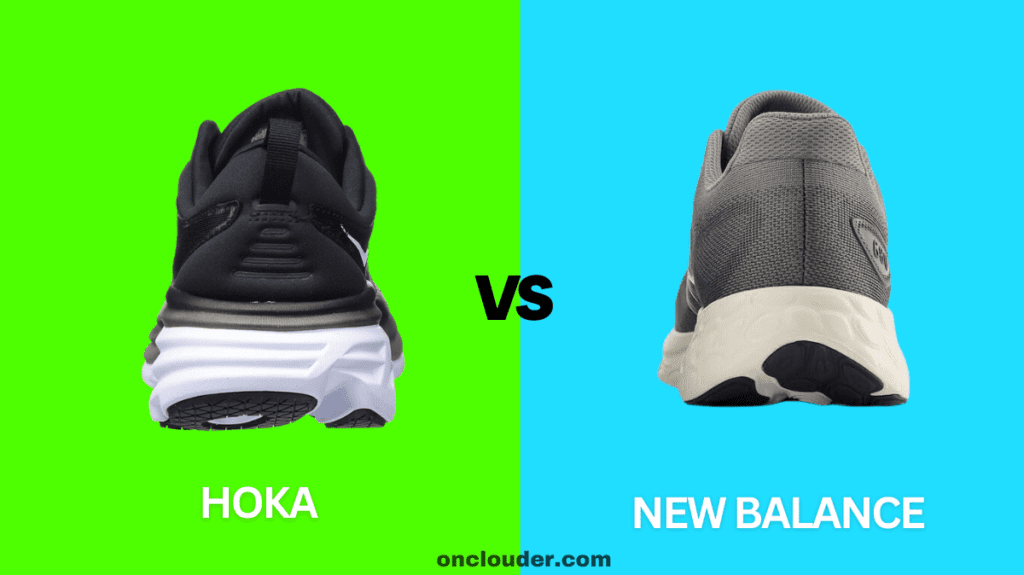
Style
Hoka: Bold and Unique
Hoka shoes stand out with their thick soles and bright colors. They have a modern, sporty look that some people really like. When Hoka first came out, their shoes looked very different from other running shoes. They’ve become more popular over time, and now you’ll see many people wearing them for both sports and everyday use.
Hoka often uses bright, eye-catching color combinations in their shoes. This can be great if you like to make a statement with your footwear. However, they also offer more subdued color options if you prefer a less noticeable look.
The distinctive thick sole of Hoka shoes is part of their style. It gives them a unique profile that’s easily recognizable. Some people love this look, while others find it too chunky.
Hoka has been expanding their style options in recent years. While they’re still known for their maximalist running shoes, they now offer styles that are more suitable for casual wear too.
New Balance: Classic and Versatile
New Balance offers a wide range of styles. They have classic designs that look good with many outfits, as well as more modern options. New Balance has been around for a long time, and some of their shoe designs have become classics in the sneaker world.
One of New Balance’s strengths is that many of their shoes work well for both athletic activities and casual wear. You’ll often see people wearing New Balance shoes with jeans or casual outfits, as well as for running or working out.
New Balance tends to have a more understated style compared to Hoka. They offer shoes in a range of colors, from bright and bold to simple and classic. Many of their shoes have a retro-inspired look that’s become very popular in recent years.
New Balance also offers a range of width options in many of their styles. This means you can often find a shoe that both fits well and looks good, which isn’t always easy for people with wide or narrow feet.
Also Read: On Cloud vs Hoka
Weight
Hoka: Surprisingly Light
Despite their thick soles, many Hoka shoes are quite light. This can be good for running or walking long distances. Hoka uses lightweight foams and materials to keep the weight down, even with the extra cushioning.
The weight of Hoka shoes can vary depending on the model. Their racing shoes are often very light, while their trail running shoes might be a bit heavier due to extra features for durability and traction.
Many runners are surprised by how light Hoka shoes feel when they first try them on. The thick sole can make the shoes look heavy, but they often weigh about the same as other running shoes.
New Balance: Varies by Model
New Balance has both light and heavier shoes. Their running shoes are often lightweight, while some walking or training shoes might be a bit heavier. This variety allows you to choose a shoe that’s the right weight for your needs.
New Balance uses different materials and technologies to manage the weight of their shoes. For example, their Fresh Foam X technology provides cushioning while keeping weight down. Their racing shoes, like the FuelCell RC Elite, are designed to be very lightweight for fast running.
On the other hand, some New Balance shoes, especially those designed for durability or extra support, might be heavier. This extra weight often comes from features that make the shoes more supportive or long-lasting.
When comparing the weight of New Balance and Hoka shoes, it’s important to look at specific models rather than the brand as a whole. Both brands offer shoes at various weights to suit different needs.
Flexibility
Hoka: Stiff but Responsive
Hoka shoes can be a bit stiff due to their thick soles. However, they often have special designs to help your foot move naturally. The Meta-Rocker technology in Hoka shoes is designed to help your foot roll through its natural motion, from heel strike to toe-off.
While Hoka shoes might not be as flexible as some very minimalist shoes, many runners find that they still allow for a natural stride. The stiffness can actually be an advantage in some cases, providing a stable platform and helping to propel you forward.
Some Hoka models are more flexible than others. Their trail running shoes, for example, often have more flexibility to help your foot adapt to uneven terrain. If you prefer a more flexible shoe, look for Hoka models with names that include words like “flux” or “fly,” as these often indicate a more flexible design.
New Balance: Range of Options
New Balance offers shoes with different levels of flexibility. You can find very bendy shoes or stiffer ones, depending on what you need. This variety allows you to choose a shoe that matches your running or walking style.
Some New Balance shoes, especially those designed for speed, are quite flexible. These shoes allow your foot to move very naturally and can be good for runners who prefer a more minimalist feel.
Other New Balance shoes, particularly those designed for stability or trail running, might be stiffer. This stiffness can provide support and protection, which can be beneficial for some runners or for running on rough terrain.
New Balance also uses technologies like their Fresh Foam X, which is designed to be soft yet responsive. This can provide a good balance between flexibility and support.
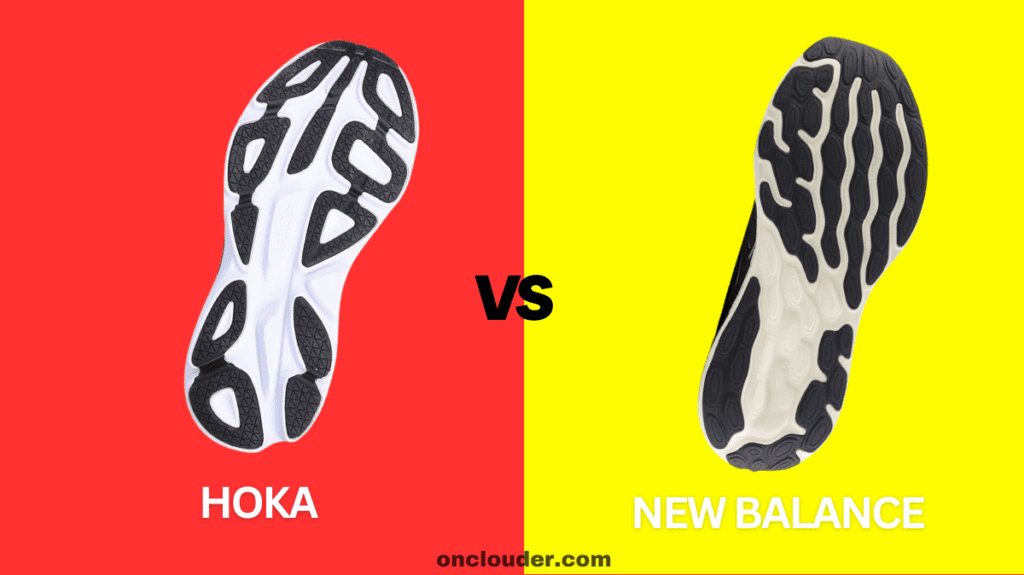
Water Resistance
Hoka: Some Water-Resistant Options
Hoka has some shoes designed for trail running that offer some protection against water. However, most of their shoes are not fully waterproof. The water-resistant models often have special treatments on the upper part of the shoe to help repel water.
For example, some Hoka trail running shoes use water-resistant materials or have a waterproof membrane. These can be good for running in wet conditions or on trails where you might encounter puddles or streams.
However, if you need a fully waterproof shoe, you might need to look at Hoka’s specific waterproof models or consider using a waterproofing treatment on your shoes.
It’s worth noting that very breathable shoes (which many Hoka models are) often aren’t very water-resistant, as the same openings that let air in can also let water in.
New Balance: Weather-Ready Choices
New Balance offers several water-resistant and waterproof options, especially in their outdoor and trail running lines. They use technologies like their Fresh Foam Hierro, which includes a water-resistant upper, or Gore-Tex membranes in some models for full waterproofing.
New Balance’s waterproof shoes can be good for running or walking in wet conditions, or for wearing in rainy weather. However, like with Hoka, these waterproof models might be less breathable than non-waterproof options.
New Balance also offers water-resistant treatments on some of their casual shoes, which can be helpful for everyday wear in damp conditions.
Sole Design
Hoka: Unique Rocker Shape
Hoka soles have a special curved shape that can help you move smoothly from heel to toe. This can be great for running. This design, called Meta-Rocker, is one of Hoka’s signature features.
The Meta-Rocker sole is designed to help propel you forward and make your stride more efficient. It can be especially helpful for heel strikers (people who land on their heel first when running) by helping to smooth the transition from heel to toe.
Hoka soles are also known for their thickness. This extra cushioning can help absorb shock and reduce impact on your joints. However, it also means you’re higher off the ground, which some people find takes getting used to.
Many Hoka shoes also have wide soles, especially in the forefoot area. This can provide extra stability and a larger platform for push-off when you’re running or walking.
New Balance: Varied Tread Patterns
New Balance uses different sole designs for different purposes. Their running shoes have patterns for grip on roads, while trail shoes have deeper treads for rough ground.
For road running shoes, New Balance often uses relatively smooth soles with strategically placed grooves and patterns. These are designed to provide good traction on pavement while still being durable.
New Balance trail running shoes usually have more aggressive tread patterns, with deeper lugs (the sticky-out bits on the bottom of the sole). These provide better grip on loose or uneven surfaces like dirt trails.
New Balance also varies the hardness of their soles depending on the shoe’s purpose. Racing shoes might have harder, more responsive soles, while comfort-focused shoes might have softer soles for more cushioning.
Material Quality
Hoka: High-Tech Fabrics
Hoka uses modern materials to make their shoes light and durable. They often use special foams in their soles for extra cushioning. Hoka’s midsoles (the layer between the insole and the outer sole) are often made from EVA (ethylene-vinyl acetate) foam or their own proprietary foams. These are designed to provide lots of cushioning while still being lightweight.
For the upper part of the shoe, Hoka often uses engineered mesh. This is a type of fabric that can be made more or less stretchy or breathable in different areas of the shoe. This allows them to provide support where it’s needed while keeping the shoe lightweight and breathable.
In their trail running shoes, Hoka sometimes uses more durable materials like reinforced rubber or tougher fabrics to protect against rocks and rough terrain.
New Balance: Reliable Materials (continued)
New Balance uses a mix of traditional and modern fabrics to make comfortable, long-lasting shoes. They often use EVA foam or their own Fresh Foam and FuelCell technologies in their midsoles for cushioning and responsiveness.
For uppers, New Balance uses engineered mesh, synthetic leather, and sometimes real leather. Their trail shoes often incorporate more durable materials for protection against rough terrain.
New Balance is known for their attention to detail in construction, using reinforced stitching in high-wear areas for improved durability.
User Reviews and Ratings
Here’s what people are saying about these brands:
| Brand | Overall Rating | Comfort | Durability | Style |
| Hoka | 4.5/5 ⭐⭐⭐⭐½ | 5/5 ⭐⭐⭐⭐⭐ | 4/5 ⭐⭐⭐⭐ | 4/5 ⭐⭐⭐⭐ |
| New Balance | 4.3/5 ⭐⭐⭐⭐ | 4.5/5 ⭐⭐⭐⭐½ | 4.5/5 ⭐⭐⭐⭐½ | 4.5/5 ⭐⭐⭐⭐½ |
Hoka receives high praise for comfort, particularly for long-distance running. Users appreciate the cushioning but some find the style polarizing.
New Balance gets consistent ratings across categories. Users often mention the variety of width options and the balance between comfort and support.
Price Comparison
Here’s a general price range for different types of shoes from both brands:
| Shoe Type | Hoka Price Range | New Balance Price Range |
| Running | $130 – $200 | $80 – $180 |
| Walking | $120 – $170 | $70 – $150 |
| Trail | $140 – $210 | $90 – $170 |
Hoka tends to be slightly more expensive, especially for their high-end models. New Balance offers a wider price range, including more budget-friendly options.
Pros and Cons
| Feature | Hoka | New Balance |
| Pros ✅ | Very soft cushioning | Many width options |
| Great for long runs | Various cushioning levels | |
| Unique style | Traditional look | |
| Light for their size | Often less expensive | |
| Cons ⚠️ | Can feel unstable | Less max cushioning |
| Look too big for some | Heavier models available | |
| Often more expensive | Less unique style | |
| Fewer width options | Some find fit inconsistent |
In conclusion: Both Hoka and New Balance offer quality shoes with distinct strengths. Hoka excels in cushioning and comfort, making them popular for long-distance running and people seeking maximum impact protection. Their unique style and thick soles set them apart visually.
New Balance offers more variety in terms of style, width, and price. They provide a good balance of comfort and support, with options suitable for various activities and preferences. Their classic designs and width options make them versatile for both athletic and casual use.
Are Hoka shoes good for everyday wear?
Yes, many people find Hoka shoes comfortable for daily use, especially if you’re on your feet a lot. Their cushioning can provide all-day comfort.
Do New Balance shoes run true to size?
Generally yes, but it can vary by model. It’s best to check the sizing guide for each specific shoe. New Balance’s variety of width options can help you find the right fit.
Can I use Hoka shoes for sports other than running?
Absolutely! While they’re popular for running, many Hoka shoes work well for walking, gym workouts, and other activities. They offer models designed for various sports.
Are New Balance shoes good for wide feet?
Yes, New Balance is known for offering many width options, making them a great choice for people with wide feet. They offer widths from narrow (B) to extra-wide (4E) in many models.
Which brand is better for people with foot pain?
Both brands offer shoes that can help with foot pain. Hoka’s extra cushioning might help some people, while New Balance’s variety of support options could be better for others. For specific foot issues, it’s best to consult with a doctor or podiatrist.

